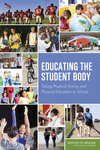 In a time when school budgets are stressed and school performance is judged more and more on standardized test scores, it’s understandable that certain aspects of the school day that can seem less-critical get cut back or cut out altogether. Student physical activity and physical education has been one of those things slowly reduced over the years to make time and resources available for more classroom instruction.
In a time when school budgets are stressed and school performance is judged more and more on standardized test scores, it’s understandable that certain aspects of the school day that can seem less-critical get cut back or cut out altogether. Student physical activity and physical education has been one of those things slowly reduced over the years to make time and resources available for more classroom instruction.
While this can certainly seem to make sense given the academic mission of schools, a new report out from the Institute of Medicine (IOM) argues forcefully that such cuts in active time for students is a short-sighted fix that can ultimately hurt students and schools, since active kids are more productive, healthier, and perform better academically (see video below).
With half of students not meeting recommended levels of daily physical activity, reintegrating activity and physical education back into the school environment could have large payoffs not only in terms of short-term health and academic success but also in students’ later adult lives, helping them be more productive and active members of their communities.
So important is regular activity, that the IOM recommends that it be recognized by the federal government, states, and school systems as a “core subject” because it is foundational to learning. And the new report provides a number of recommendations for integrating or improving the physical activity and physical education in schools.
Though there is no such thing as a magic bullet for good health, physical activity is as close to one as we’ll ever get. It lowers the risk of many important diseases, keeps weight in check, keeps people agile as they age, and provides a good boost to mental mood. Laying the foundation for a life filled with enjoyable exercise and activity can’t start too early, and the school setting is one of the best places to do this.
